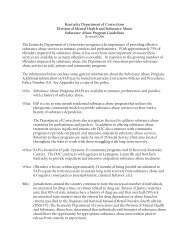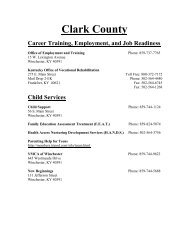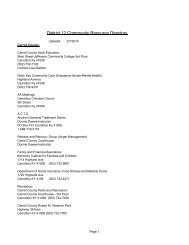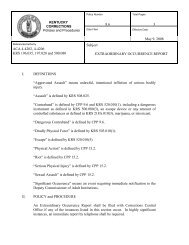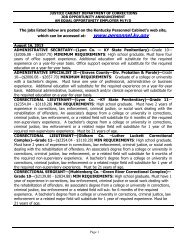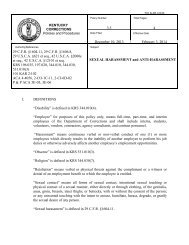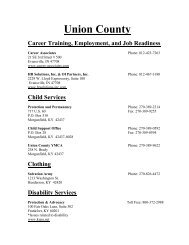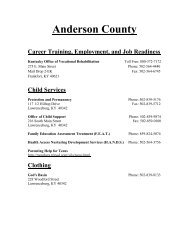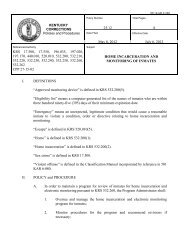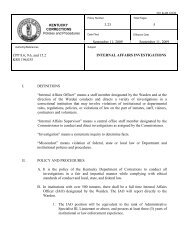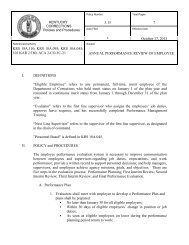Homeward Bound - Kentucky Department of Corrections
Homeward Bound - Kentucky Department of Corrections
Homeward Bound - Kentucky Department of Corrections
Create successful ePaper yourself
Turn your PDF publications into a flip-book with our unique Google optimized e-Paper software.
<strong>Homeward</strong> <strong>Bound</strong> Offender Newsletter June 2012A S E C O N DC H A N C E T OM A K EA F I R S TI M P R E S S I O NS P E C I A LP O I N T S O FI N T E R E S T :• Art ProjectToStrengthenFamilies• Jail mural inthe exitlobby <strong>of</strong> theLouisvilleMetro jail inJeffersonCountyI N S I D E T H I SI S S U E :Art in the Jail 1-6Most7FrequentlyAskedQuestionsHOMEWARD BOUNDV O L U M E 2 , I S S U E 6J U N E 2 0 1 2KY DOC Supports Art To Strengthen FamiliesAffected by Incarceration by Judi JenningsChange <strong>of</strong>ten begins with imagining a new way <strong>of</strong> doing things. Inthe case <strong>of</strong> the mural pictured on page 6, now permanently installed inthe exit lobby <strong>of</strong> the Louisville Metro Jail, change began as a visionaryconcept by dedicated corrections <strong>of</strong>ficers who believed that art hasa place in the halls <strong>of</strong> justice.As the <strong>of</strong>ficers imagined art inside the jail, a mother participating invideo visitations with her incarcerated son envisioned how artactivities could make the visitors lobby more welcoming andsupportive <strong>of</strong> children and families impacted by incarceration.Initially unconnected, these two great ideas merged in 2007-thanks tothe generous anonymous donation <strong>of</strong> the mother and the support <strong>of</strong>art-friendly allies within the Louisville Metro <strong>Department</strong> <strong>of</strong><strong>Corrections</strong>.Today, an innovative approach to strengthening families affected byincarceration is beginning to emerge as a result <strong>of</strong> a uniquepartnership between the <strong>Kentucky</strong> Foundation for Women (KFW)and its local and state-level allies in the <strong>Department</strong> <strong>of</strong> <strong>Corrections</strong>.Incorporating great ideas in 2007 led to KFW commissioning twohighly skilled visual artists to collaborate with more than one hundredpeople, including jail staff, incarcerated persons and their loved ones,to identify positive images that evoke the importance <strong>of</strong> family,continued on page 2“A SECOND CHANCE TO MAKE A FIRST IMPRESSION” 1 1-877-INMATE 4 OR 1-877-466-2834
<strong>Homeward</strong> <strong>Bound</strong> Offender Newsletter June 2012P A G E 4Here is a scene described on one Sunday evening:“In addition to thegenerous support<strong>of</strong> the anonymousdonor, KFW’sSpecial Project hasreceivedcontributions fromtwo local churchesand severalindividuals,including twoincarceratedindividuals.”An eight-year-old boy sits at a plastic folding table, workingintently on creating a “charm bracelet.” He draws small pictures<strong>of</strong> himself, family members and loved ones to cut out and paste ona yarn band he has just woven with the help <strong>of</strong> an arts-activitiesleader. When he tries to paste some <strong>of</strong> the small pictures on theyarn, they crinkle up and won’t lie flat. Seeing his frustration, anearby teenager <strong>of</strong>fers to help, holding the small pictures straightwhile the boy applies the paste. The boy tells the teenager abouteach <strong>of</strong> the people he has drawn as he carefully places the pictureson his bracelet.An experienced art-activities leader reports, “There are severalfamilies who now know us very well. When they see us with theart box, they are eager to get started. Sometimes new visitorshesitate to approach the table; but once they begin, theydemonstrate a certain confidence that shows itself through beamingpride. Although some caregivers say it’s ‘for the kids,’ many <strong>of</strong>them make art, too, and exclaim how proud they are after theycomplete an activity. Additionally, we are establishing levels <strong>of</strong>trust with the young people there. They know each artist by nameand <strong>of</strong>ten begin conversations where they left <strong>of</strong>f the previous timewe saw them. The art activities create a more welcomingenvironment and increase positive factors <strong>of</strong> accomplishment asvisitors <strong>of</strong> all ages and backgrounds learn new skills andcreate art they can show their incarcerated loved one viavideo and take home and share with others.”KFW’s Special Project has received contributions fromtwo local churches and several individuals, including twoincarcerated individuals. Ms. Williams still serves asNational Artistic Director to the Special Project, andremains committed to its further development.“A SECOND CHANCE TO MAKE A FIRST IMPRESSION” 4 1-877-INMATE 4 OR 1-877-466-2834
<strong>Homeward</strong> <strong>Bound</strong> Offender Newsletter June 2012V O L U M E 1 , I S S U E 1P A G E 5In addition to the generous support <strong>of</strong> the anonymous donor, KFW’s Special Project hasreceived contributions from two local churches and several individuals, including twoincarcerated individuals. Ms. Williams still serves as National Artistic Director to theSpecial Project, and remains committed to its further development.Beginning in January, 2012, KFW embarked on a partnership with the <strong>Kentucky</strong><strong>Department</strong> <strong>of</strong> <strong>Corrections</strong> to educate the larger community about the power <strong>of</strong> art tostrengthen families and serve as an integral part <strong>of</strong> successful reentry. In cooperationwith two Re-Investment Neighborhood Groups (RINGs) in the Shawnee and Newburgareas <strong>of</strong> Louisville, the <strong>Kentucky</strong> Foundation for Women’s Special Project is expandingits activities to community-based settings and its vision to strengthen the protectivefactors in children after they’re reunited with formerly incarcerated parents.Collaboration with highly respected and well-established youth and family-orientedservice organizations is a key factor in introducing art-based activities to families in theseareas. KFW does not withhold any <strong>of</strong> the contributed funds for administrative costs; allfunds are applied directly to strengthening families and to the crucial reentry work beingdone in the Louisville Metro area. Special Project staff and art activities team membersinvest over thirty cumulative hours a month exploring collaborative opportunities, creatingand fine-tuning artistic programming, and facilitating family bonding activities with thechildren and families who are committed to supporting their loved ones during, and after,incarceration.If you would like more information about the Special Project, and its ongoing dedicationto the health and wholeness <strong>of</strong> <strong>Kentucky</strong>’s families who are impacted by incarceration,please contact KFW executive director, Judi Jennings at Judi@Kfw.org .Please see page 6 for a picture <strong>of</strong> the mural and two photos <strong>of</strong> close-up work for detail.“A SECOND CHANCE TO MAKE A FIRST IMPRESSION” 5 1-877-INMATE 4 OR 1-877-466-2834
<strong>Homeward</strong> <strong>Bound</strong> Offender Newsletter June 2012Tile Mosaic located in the exit lobby <strong>of</strong> Louisville Metro JailThese two enlarged views <strong>of</strong> the mosaic represent “positiveimages that evoke the importance <strong>of</strong> family, nurture, hopeand new beginnings”.“A SECOND CHANCE TO MAKE A FIRST IMPRESSION” 6 1-877-INMATE 4 OR 1-877-466-2834
<strong>Homeward</strong> <strong>Bound</strong> Offender Newsletter June 2012MOST FREQUENTLYASKED QUESTIONSQUESTION: What are the basic principles <strong>of</strong> evidence-based practice?ANSWER: Three basic principles <strong>of</strong> evidence-based practice have been gathered fromthe scientific research about what work to reduce recidivism among <strong>of</strong>fenders undercommunity supervision: 1) the risk principle; 2) the needs principle, and 3) thetreatment principle.QUESTION: What do we mean by an “intervention”?ANSWER: Intervention refers to any planned activity to change <strong>of</strong>fenderbehavior which can include a rehabilitation program, probation supervision practice,or even a judge’s courtroom conversation with the <strong>of</strong>fender if undertaken for thatpurpose.QUESTION: What are “static” and “dynamic” risk factors?ANSWER: First, “risk factors” are <strong>of</strong>fender characteristics that are associated withhigher likelihood <strong>of</strong> future criminality. “Static” risk factors are risk factors such as age,gender, age at first arrest and prior criminal history that predict future criminalityand cannot be changed or reduced in order to reduce the risk <strong>of</strong> re-<strong>of</strong>fense. Risk <strong>of</strong>recidivism is dynamic; it changes over time, increasing and decreasing in light <strong>of</strong>changing circumstances in an <strong>of</strong>fender’s life and choices made by the <strong>of</strong>fender. Risk isalso changeable: it can be changed by effective intervention. “Dynamic risk factors(also knows as “criminogenic needs”) refer to those risk factors that predict futurecriminality but that also can be changed or reduced in order to reduce the risk <strong>of</strong> re<strong>of</strong>fense.“A SECOND CHANCE TO MAKE A FIRST IMPRESSION” 7 1-877-INMATE 4 OR 1-877-466-2834



